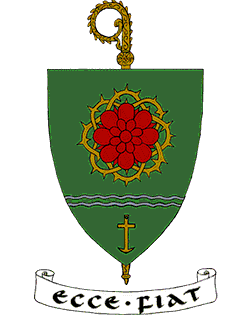Dear Friend of Clear Creek Abbey,
Our abbey belongs to a family of monasteries, the Congregation of Solesmes. Every four years, abbots from various parts of the world travel to France in order to attend the General Chapter at Saint-Pierre-de-Solesmes Abbey, on the banks of the Sarthe River. On Low Sunday, in company with the young monk who was to be my socius (in monastic language, my traveling companion), I boarded a plane to Paris.
Once we arrived in Sablé, at the nearest train station to the Abbey, we decided to walk the last few miles to our destination rather than asking to be shuttled in an automobile. It was a glorious spring day, but just a bit on the warm side. As we made our way along the footpath by the Sarthe, our bags became heavier and our black wool habits began to absorb a generous portion of the sunshine. There was also the minor detail that we had passed a completely sleepless night crossing the Atlantic. But we made it! As we approached the beautiful bridge that would carry us across the river, we contemplated the imposing spiritual fortress everyone simply refers to as “Solesmes.”
The first order of business was to say our “low” Masses in the crypt, where the founder, Dom Guéranger, and the other abbots of Solesmes are buried. We were at the heart of the Mother House.
By the time Vespers came around, most of the abbots had arrived. Over the choir stall of each abbot was placed a beautifully painted crest bearing the coat-of-arms of his abbey. It was a memorable scene. There is something unique about the acoustics of that choir constructed in the time of Dom Guéranger. When it comes to the singing of Gregorian chant, it is something like perfection. The monastic choir of Solesmes, famous for its chant even to this day, did not disappoint us.
During the first few days of the General Chapter, while I attended meetings, my socius explored every nook and cranny of the house. He then traveled by car to Fontgombault Abbey with a French family, after scaling a large stone wall on the morning of his departure since he could not find an open gate at that early hour. The General Chapter ran its course of conferences and exchanges, including a special parloir with the nuns of Sainte-Cecile on Sunday, followed by Vespers alternated between the nuns and the abbots. It was a very good Chapter.
On the final day, after each abbot had signed and placed his abbatial seal on the official text or Acta of the proceedings, we departed, each in his own direction. I traveled by car to Fontgombault Abbey with two French monks I have known for many years. We stopped along the way at a little town called L’Île-Bouchard, where in 1947 the Blessed Virgin appeared to four children. We recited a decade of the Rosary in the church of the apparitions and then continued on to the abbey.
If Solesmes is the source, the spiritual spring, whence originated our particular monastic family founded by Dom Prosper Guéranger, Fontgombault too deserves the name of “source” in a special way. The very name “Fontgombault” means “the spring of Gombaud.” In the Middle Ages, a knight returning from the Crusades stopped in the cave across the river from the present abbey, where an abundant spring of pure water still flows today. He adopted the monastic life and dwelt there as a hermit. Some years later another hermit, named Peter of the Star, took up his abode in the same cave. After many years had passed and he had gathered many followers, Peter of the Star built a monastery for “cenobites” on the opposite side of the Creuse River. Fontgombault’s well chosen motto, Fons Amoris, “Fountain of Love,” is drawn from the invocations of the Litany of Loretto for Our Lady.
Fontgombault is the source of the monastic adventure that led to the founding of Clear Creek. It was at Fontgombault in 1972 that our friends Stew Ashton and Arthur Anderson (now deceased) first came into contact with the monastic community that was to establish our monastery in Oklahoma. Coming back to Fontgombault is thus a pilgrimage to the fountainhead of our monastic life, where there remains the living memory of countless generations of monks and an almost tangible presence of Our Lady.
After several days at Fontgombault, my socius and I continued our trek across monastic France in the company of the abbot of Notre-Dame de Triors. On our way to Triors we stopped at Notre-Dame de Randol in the beautiful mountains of Auvergne. Both Randol and Triors were founded by Fontgombault.
The last stage of our monastic pilgrimage took us to Provence in the south of France, where we were the guests of the Benedictine nuns at Cotignac. This charming monastery, tucked away on a rocky hillside, was built on the site of an apparition of Saint Joseph in the 17th century. Here too there is a miraculous water source (of which we gladly drank). It is said that a young peasant, in desperate need of water one day, met a kindly old stranger who caused a spring of water to gush forth. Before disappearing, he revealed his name as Joseph. Ever since, pilgrims have come to this miraculous water for healing and countless graces. While at Cotignac, we had the joy of assisting at the solemn profession of a French nun. Before returning by train to Paris to catch our homebound plane, we visited nearby Jouques Abbey, a wonderful place, where there is an American nun from Oklahoma.
We took advantage of this outing to visit one of the gems of Cistercian architecture in France, the abbey of Silvacane. In this deserted church, something of a tourist attraction at certain hours, we paused for a moment in the sacred silence (there were no visitors just then), under the high vaulted ceiling, and sang a Salve Regina in thanksgiving for our journey. In that Salve was also placed the hope that some day Silvacane and so many other places like it would reawaken to the fervent monastic life it once knew, and that the flame of the great monastic adventure, begun in Egypt and continued in Europe, would burn ever brighter in the Church—even across the great sea in our America.
+ br. Philip Anderson, abbot




